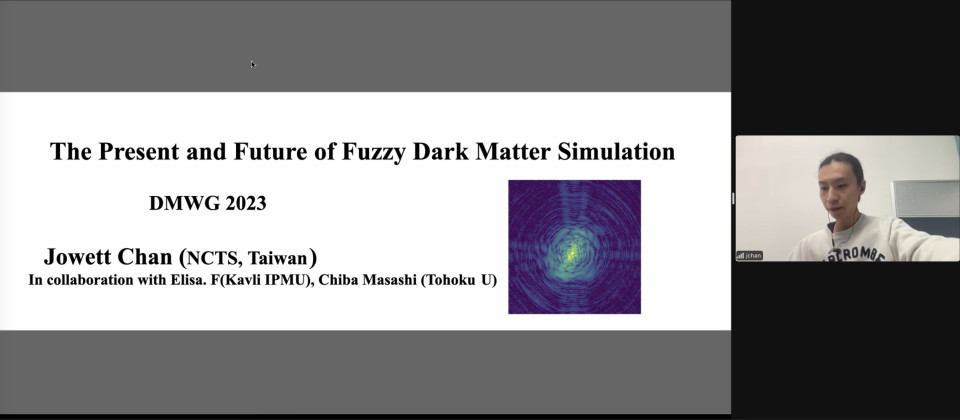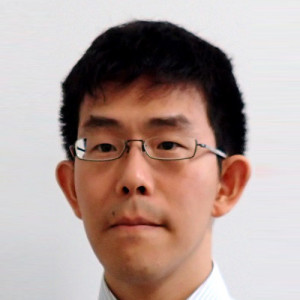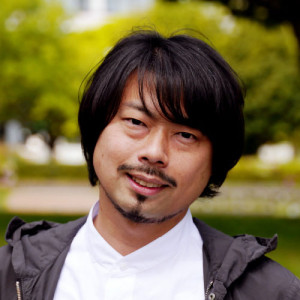Volume 239
Back to Newsletter List
Seminar Report
DMWG Seminar by Dr. Jowett Chan on February 9, 2023
2023-02-20
Dark matter (DM) of our Universe could be categorized into three types: cold DM (CDM), warm DM (WDM), or fuzzy DM (FDM) depending on its mass. CDM is the most well-studied one with its success in large-scale structure formations. However, as studies proceed, some problems arise in such models: observations of small-structure would not match the predictions of CDM structures in simulations. For example, observations of Milky Way satellites indicate the existence of the central core while simulations predict cuspy structures at the center. The feature could be well-described by considering FDM of m~O(1e-20) eV or below.
The unique point of FDM is that the mass of the particle becomes a unique parameter for calculation. In numerical simulations of FDM halos, we can see the formation of cores in the Hubble time (i.e. the age of the Universe) and relaxations of radial structures. As the test particle mass gets larger, core-formation time becomes longer.
One possible caveat for FDM models is the so-called "diversity problem". Our satellite galaxies show diversity in their core structures, while FDM predicts a single scale for core size which is determined by the particle mass. It can be understood by considering non-linear processes of mergers, the diversity could be generated. Mergers could also be responsible for structures at outer radii, such as the density profile proportional to the inverse cubic of the radius.
In order to overcome the numerical difficulties and proceed, GPU-accelerated adaptive mesh code is now being intensively invented. We should see fantastic structures of FDM halos in the near future!
Reported by Nagisa Hiroshima
Fuzzy DM simulation (TBA)
February 9 (Thu) 11:00 - 12:00, 2023
Upcoming Events
Seminar
NEW WG Seminar
How to sit Maxwell and Higgs on the boundary of AdS
February 28 (Tue) 13:30 - 15:00, 2023
Matteo Baggioli (Associate Professor, School of Physics and Astronomy, Shanghai Jiao Tong University, China)
Within the holographic correspondence, boundary conditions play a fundamental role in determining the nature of the dual field theory. In this talk, I will show how to exploit mixed boundary conditions to obtain dynamical electromagnetism in the boundary theory. This is necessary to apply AdS-CFT to many real-world applications, e.g., magnetohydrodynamics, plasma physics, superconductors, etc. where dynamical gauge fields and Coulomb interactions are fundamental. As a proof of concept, I will show two emblematic cases. First, I will prove that the results from the 4-dimensional Einstein-Maxwell bulk theory with these deformed boundary conditions are in perfect agreement with relativistic magneto-hydrodynamics in 2+1 dimensions. Second, I will discuss the collective excitations of a bona-fide holographic superconductor and prove the existence of the Anderson-Higgs mechanism therein.
Venue: Room 6209, Korakuen Campus, Chuo University / via Zoom
Event Official Language: English
Seminar
Quantum Matter Seminar
Topological Kondo superconductors
March 2 (Thu) 17:00 - 18:15, 2023
Yung-Yeh Chang (Postdoctoral Researcher, National Center for Theoretical Sciences & National Chiao Tung University, Taiwan)
Spin-triplet p-wave superconductors are promising candidates for topological superconductors. They have been proposed in various heterostructures where a material with strong spin-orbit interaction is coupled to a conventional s-wave superconductor by proximity effect. However, topological superconductors existing in nature and driven purely by strong electron correlations are yet to be studied. Here we propose a realization of such a system in a class of Kondo lattice materials in the absence of proximity effect. Therein, the odd-parity Kondo hybridization mediates ferromagnetic spin-spin coupling and leads to spin-triplet resonant-valence-bond (t-RVB) pairing between local moments. Spin-triplet p±p’ wave topological superconductivity is reached when Kondo effect co-exists with t-RVB [1]. We identify the topological nature by the non-trivial topological invariant and the Majorana zero modes at edges. Our results on the superconducting transition temperature, Kondo coherent scale, and onset temperature of Kondo hybridization not only qualitatively but also quantitatively agree with the observations for UTe2, a U-based ferromagnetic heavy-electron superconductor.
*This work is supported by the National Science and Technology Council, Taiwan.
Field: condensed matter physics
Keywords: strongly correlated systems, topological superconductor, Kondo effect, resonant valence bond, heavy-fermion compounds
Reference
- Yung-Yeh Chang, Khoe Van Nguyen, Kuang-Lung Chen, Yen-Wen Lu, Chung-Yu Mou, and Chung-Hou Chung, (2023), arXiv: 2301.00538
Venue: via Webex
Event Official Language: English
Seminar
ABBL-iTHEMS Joint Astro Seminar
Cosmic magnetism and its effects on the observed properties of ultra high-energy cosmic rays
March 10 (Fri) 14:00 - 15:00, 2023
Ellis Owen (JSPS International Research Fellow, Theoretical Astrophysics Group, Department of Earth and Space Science, Graduate School of Science, Osaka University)
Ultra high-energy (UHE) cosmic rays (CRs) from distant sources interact with intergalactic radiation fields, leading to their spallation and attenuation through photo-hadronic processes. Their deflection and diffusion in large scale intergalactic magnetic fields (IGMFs), in particular those associated with Mpc-scale structures, alter the cumulative cooling and interactions of a CR ensemble to modify their spectral shape and composition observed on Earth. In this talk, I will demonstrate the extent to which IGMFs can affect observed UHE CRs, and show that source population models are degenerate with IGMF properties. Interpretation of observations, including the endorsement or rejection of any particular UHE CR source classes, needs careful consideration of the structural properties and evolution of IGMFs. Future observations providing tighter constraints on IGMF properties will significantly improve confidence in assessing UHE CR sources and their intrinsic CR production properties.
Venue: via Zoom / Common Room #246-248, 2F Main Research Building, RIKEN
Event Official Language: English
Seminar
iTHEMS Theoretical Physics Seminar
Towards S-matrix theory of unstable particles
March 15 (Wed) 13:30 - 15:00, 2023
Katsuki Aoki (Research Assistant Professor, Yukawa Institute for Theoretical Physics, Kyoto University)
The S-matrix is one of the central objects in quantum field theory and gains renewed interest recently to understand the possible structures of low-energy effective field theories and quantum gravity. However, most of the particles have finite decay widths and thus do not appear in asymptotic states. Therefore, the standard S-matrix arguments may not be directly applied to scatterings of such unstable particles and we need to formulate “the S-matrix theory of unstable particles” to properly understand the availability of the S-matrix arguments in realistic systems. In this talk, I will talk about the first steps towards this goal. In particular, I will discuss non-perturbative consequences of unitarity in a scattering amplitude of unstable particles and its analytic properties.
Venue: Hybrid Format (Common Room 246-248 and Zoom)
Event Official Language: English
Seminar
iTHEMS Theoretical Physics Seminar
Spectral correlations and scrambling dynamics in Sachdev-Ye-Kitaev type models
May 30 (Tue) 13:30 - 15:00, 2023
Masaki Tezuka (Assistant Professor, Division of Physics and Astronomy, Graduate School of Science, Kyoto University)
Note: Due to unexpected trouble, we have made the decision to postpone the seminar scheduled for February 21 to May 30. Sorry for the trouble.
Abstract:
The Sachdev-Ye-Kitaev (SYK) model, proposed in 2015, is a quantum mechanical model of N Majorana or complex fermions with all-to-all random four-body interactions. The model has attracted significant attention over the years due to its features such as the existence of the large-N solution with maximally chaotic behavior at low temperatures and holographic correspondence to low-dimensional gravity.
The sparse version of the SYK model reproduces essential features of the original model for reduced numbers of disorder parameters. We recently proposed [1] a further simplification, where we set the nonzero couplings to be +1 or -1 rather than sampling from a continuous distribution such as Gaussian. This binary-coupling model exhibits strong correlations in the spectrum, as observed in the spectral form factor, more efficiently in terms of the number of nonzero terms than in the Gaussian distribution case. We also discuss the scrambling dynamics with the binary-coupling sparse SYK model, comparing the model with the original model as well as the SYK model with random two-body terms [2], where the localization of the many-body eigenstates in the Fock space has been quantitatively studied [3,4].
References
- Masaki Tezuka, Onur Oktay, Enrico Rinaldi, Masanori Hanada, and Franco Nori, Binary-coupling sparse Sachdev-Ye-Kitaev model: An improved model of quantum chaos and holography, Phys. Rev. B 107, L081103 (2023), doi: 10.1103/PhysRevB.107.L081103, arXiv: 2208.12098
- Antonio M. García-García, Bruno Loureiro, Aurelio Romero-Bermúdez, and Masaki Tezuka, Chaotic-Integrable Transition in the Sachdev-Ye-Kitaev Model, Phys. Rev. Lett. 120, 241603 (2018), doi: 10.1103/PhysRevLett.120.241603
- Felipe Monteiro, Tobias Micklitz, Masaki Tezuka, and Alexander Altland, Minimal model of many-body localization, Phys. Rev. Research 3, 013023 (2021), doi: 10.1103/PhysRevResearch.3.013023
- Felipe Monteiro, Masaki Tezuka, Alexander Altland, David A. Huse, and Tobias Micklitz, Quantum Ergodicity in the Many-Body Localization Problem, Phys. Rev. Lett. 127, 030601 (2021), doi: 10.1103/PhysRevLett.127.030601, arXiv: 2012.07884
Venue: Hybrid Format (3F #359 and Zoom), Main Research Building, RIKEN Wako Campus
Event Official Language: English
Workshop
Supported by iTHEMS
6th Workshop on Virus Dynamics
July 4 (Tue) - 6 (Thu) 2023
Catherine Beauchemin (Deputy Program Director, RIKEN Interdisciplinary Theoretical and Mathematical Sciences Program (iTHEMS))
Shingo Iwami (Professor, Graduate School of Science, Nagoya University)
The Workshop on Virus Dynamics is an international meeting held every 2 years. It brings virologists, immunologists, and microbiologists together with mathematical and computational modellers, bioinformaticians, bioengineers, virophysicists, and systems biologists to discuss current approaches and challenges in modelling and analyzing different aspects of virus and immune system dynamics, and associated vaccines and therapeutics. This 6th version of the workshop builds on the success of previous ones held in Frankfurt (2013), Toronto (2015), Heidelberg (2017), Paris (2019) and virtually (2021). It is supported by the Interdisciplinary Theoretical and Mathematical Sciences (iTHEMS) program at RIKEN, by Nagoya University, and by the Japan Science and Technology Agency. Up-to-date information and registration is available via the website. The workshop is for in-person participation only (no virtual or hybrid option).
Venue: Noyori Conference Hall, Higashiyama Campus, Nagoya University
Event Official Language: English
Paper of the Week
Week 4, February 2023
2023-02-23
Title: Color superconductivity on the lattice -- analytic predictions from QCD in a small box
Author: Takeru Yokota, Yuta Ito, Hideo Matsufuru, Yusuke Namekawa, Jun Nishimura, Asato Tsuchiya, Shoichiro Tsutsui
arXiv: http://arxiv.org/abs/2302.11273v1
Title: From Entropy to Echoes: Counting the quasi-normal modes and the quantum limit of silence
Author: Naritaka Oshita, Niayesh Afshordi
arXiv: http://arxiv.org/abs/2302.08964v1
Title: A simple method for multi-body wave function of ground and low-lying excited states using deep neural network
Author: Tomoya Naito, Hisashi Naito, Koji Hashimoto
arXiv: http://arxiv.org/abs/2302.08965v1
Title: Scrambling and Recovery of Quantum Information in Inhomogeneous Quenches in Two-dimensional Conformal Field Theories
Author: Kanato Goto, Masahiro Nozaki, Shinsei Ryu, Kotaro Tamaoka, Mao Tian Tan
arXiv: http://arxiv.org/abs/2302.08009v1
Title: Effects of Coulomb and isospin symmetry breaking interactions on neutron-skin thickness
Author: Tomoya Naito, Gianluca Colò, Haozhao Liang, Xavier Roca-Maza, Hiroyuki Sagawa
arXiv: http://arxiv.org/abs/2302.08421v1
If you would like to cancel your subscription or change your email address,
please let us know via our contact form.
Copyright © iTHEMS, RIKEN. All rights reserved.





